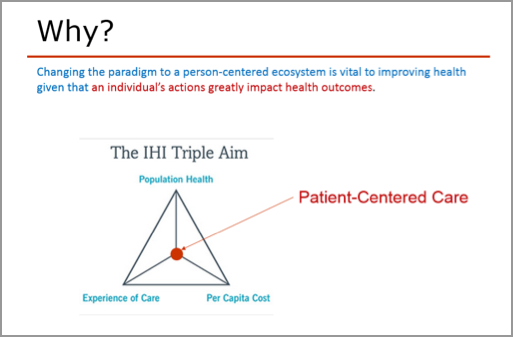The following article on Lisa Nelson and the Janie Appleseed Network will appear in the September 2016 edition of HL7 News.
Calling All Patients and Caregivers: There’s a New Birds of a Feather at HL7!
A new Birds of a Feather (BoF) session flew onto the scene at the May HL7 Working Group meeting in Montreal. The group is seeking HL7 Members interested in adding the voice of patients and caregivers to the flock of stakeholders developing standards to improve information interoperability in healthcare.
The group was convened by Lisa Nelson, an active participant in the Structured Documents, Patient Care, Templates, and other HL7 Work Groups. Lisa co-authored the Patient Generated Document Header template that is now part of the HL7 Consolidated CDA (C-CDA) standard. She also authored the recently released CDA standard for trial use (STU) for Personal Advance Care Plan Documents. Nelson is the founder of a non-profit organization called the Janie Appleseed Network (www.JanieAppleseed.net ). The mission of the Janie Appleseed Network is to cultivate the adoption of consumer-controlled electronic personal health records through a wide range of activities including participation in standards development. Nelson hopes this new HL7 BoF will attract other HL7 members passionate about adding the voice of patients and caregivers within the HL7 Working Group.
Nelson believes it’s the right time to start a group like this at HL7. The recent vision expressed in the Connecting Health and Care for the Nation report clearly spells it out, explained Nelson at the BoF session. “This report is our shared nationwide interoperability roadmap for the path forward,” she said. “It tells us to ‘embrace the value of the individual inside and outside the health care system for improving both health and care’, and it paints a picture of ‘individuals becoming effective managers of their health and wellness where they live, work and play, using information and technology’,” she quoted directly from the report.
At the BoF, the flock that gathered discussed a version of the IHI Triple Aim graphic that Nelson modified to show Patient-Centered Care at the center of the targeted goals for HIT adoption. Changing the paradigm to a person-centered ecosystem is vital to improving health, given that an individual’s actions greatly impact health outcomes, Nelson argued.
Nelson also shared a compelling call to action for HIT standards and application development based on vision set forth in the roadmap. We need systems that make it possible for the power of each individual to be developed and unleashed so they can become active in managing their health and partnering in their health care, enabled by information and technology, she urged.
The problem, Nelson said, is that people are center-stage in the model of care we are aiming to create, but currently they have no seat at the table–no voice in how systems are created and what systems are required to do. This is what Nelson hopes the new HL7 BoF will change.
“It is essential that we add People to the flock of HIT stakeholders,” advocated Nelson. “The challenge is to find a feasible way to do that. There is no organization or ‘collective’ that’s raising money to send individual patients and caregivers to HL7, HIMSS, and IHE to represent their requirements for health information technology. Most People don’t speak the language of standards development. They don’t have the knowledge to really understand what’s being discussed, and they may not even find it interesting. But, these are the subject matter experts we need to engage. People are intimately aware of the details of what health and wellness really mean in life. They know what they need and what they want in terms of the type of care and support that would help them. They know what information they want to share and access to help them get well, stay healthy, and live better lives.”
Nelson presented an idea. She suggested the group could bring the voice of patients and caregivers into HL7 by documenting a collection of patient stories based on real life experiences with health and care. The stories would be real, but techniques like those used when writing a Harvard Business Review Case would be employed to anonymize the story without eliminating essential information. The stories would be highly accurate and rich with personal, clinical, and financial information. The stories could be used to create use cases that add patient and caregiver perspectives when standards are being developed. They also could be used to create synthetic data that could be used to support trial implementations and testing of standards.
Nelson showed examples of these type of patient stories generated through the Janie Appleseed Network (www.janieappleseed.net/value-stories.html ). She also reported that the HIMSS Health Story Project (HSP) had developed a patient story of this type and created a synthetic CCD Document to encode the details of the story. The HSP story was used in an experiment at the 2016 IHE North America Connectathon with a new type of story-based testing that focused on the degree to which a CCD Document was able to capture all the details of the patient’s story.
A similarly detail-rich patient story was developed about a man managing multiple chronic conditions. The story was used as a user story in the recently published Care Plan Domain Analysis Model. A segment of that story also was used to guide a proof of concept project to explore the electronic exchange of care plan information using the C-CDA Care Plan Document standard.
The new BoF session was a great success. Twelve people met, shared personal stories, and exchanged ideas about how to grow a flock of HL7 members interested in bringing the voice of patients and caregivers into the HL7 Working Group. Participants expressed interest in creating patient stories and committed to developing some examples before the September meeting. “This session gave me goose bumps,” said Virginia Lorenzi, a strong supporter who offered many exciting ideas to expand the impact of this initiative at the September Plenary. “The energy in the room was amazing,” said John Ritter, an active member of the EHR Work Group and co-author of the Personal Health Record Functional Model. “May the wind be at our backs as we work together to move this idea forward,” he closed.
If you missed participating in the first BoF meeting, it’s still not too late to get involved. If you have interest and want to help add the patients and caregivers to the flock of stakeholders represented in HL7, send an e-mail to [email protected], and join us!

